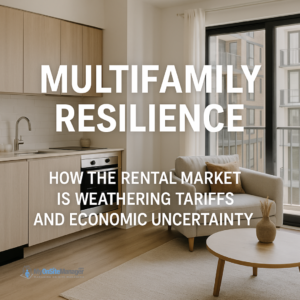Despite a complex economic environment filled with trade tensions, inflationary pressures, and policy uncertainty, the U.S. multifamily housing sector continues to demonstrate remarkable strength and stability.
According to Yardi Matrix’s latest national report, rents across the country are climbing modestly, and investor confidence in the rental market remains intact. Here’s what you need to know about the current state of the multifamily and single-family rental markets, and what these trends mean for owners, renters, developers, and investors.
National Rent Performance: Stable Growth Amid Uncertainty
March 2025 Highlights:
-
The average national multifamily rent rose by $5 from February to $1,755.
-
Quarter-over-quarter, rents have grown by 0.4%—a strong signal of seasonal demand returning.
-
Year-over-year (YOY) rent growth is at 1.0%, slightly down from previous months but still positive.
This data suggests that while the breakneck rent growth of the pandemic era has eased, the market remains fundamentally strong.
Which Cities Are Driving the Growth?
Some of the nation’s largest metros are seeing stronger-than-average performance:
-
New York City continues to rebound, with +5.5% YOY rent growth, leading the pack.
-
Chicago posted a healthy +3.7% YOY increase.
-
Boston, Miami, and Los Angeles all reported steady gains as well.
These “gateway cities” are benefiting from renewed urban demand, international migration, and high-wage job recovery—key factors that support higher rents and sustained occupancy.
By contrast, rent growth is slowing in high-supply Sun Belt markets like Austin, Nashville, and Phoenix, where the pace of new apartment deliveries is outpacing demand.
Single-Family Rentals See Slower, Steady Gains
The single-family rental (SFR) market also remains healthy:
-
In April 2025, average SFR rents rose $5, reaching $2,169 nationally.
-
While YOY rent growth has cooled substantially from 2022’s double-digit highs, demand remains robust.
Factors like remote work flexibility, the affordability gap between owning and renting, and migration into suburban markets are keeping SFR demand alive—even if growth has normalized.
What’s Behind These Trends?
1. A Surge in New Supply
Markets like Denver, Charlotte, and Austin have all seen their multifamily inventory grow by 4–5% YOY. This new supply is helping to moderate rent increases but could place pressure on landlords with high debt service obligations or short-term financing needs.
2. Macroeconomic Headwinds
Economic uncertainty is being fueled by:
-
New and ongoing tariffs, which increase construction and maintenance costs.
-
Concerns over immigration policy, which may affect labor availability and housing demand.
-
Potential job market softening, especially in tech and finance sectors, which are key renters in urban cores.
Despite these risks, Yardi notes that consumer confidence remains steady, and the capital markets supporting multifamily investment remain open.
3. Investor Opportunity in Loan Maturities
2025 will see a wave of multifamily loans maturing. For investors, this opens the door to:
-
Value-add acquisitions
-
Refinancing opportunities
-
Restructuring distressed assets
Those with strong equity positions and access to lending could benefit from motivated sellers or recapitalizations.
Occupancy Remains Resilient
Occupancy rates have held relatively firm, averaging 94.5% nationwide. While that’s down slightly from pandemic peaks, it’s a strong number considering the wave of new supply and the broader economic climate.
This level of stability means landlords can still command reasonable rent growth—especially for high-quality, well-located units.
What This Means for Stakeholders
For Renters:
-
Expect modest rent increases in most markets.
-
Competitive leasing seasons are returning, especially in top-tier metros.
-
Budgeting early and acting quickly on lease renewals could be key this summer.
For Property Owners & Managers:
-
Prioritize operational efficiency, especially in high-supply regions.
-
Watch capital expenses as tariffs and inflation affect vendor pricing.
-
Consider value-add or tech-driven upgrades to stay competitive without aggressive rent hikes.
For Investors & Developers:
-
Strong occupancy and modest rent growth present a favorable outlook.
-
Rising interest rates and refinancing needs in 2025 will test portfolios.
-
Long-term fundamentals—migration trends, household formation, and supply limits—still support multifamily investment.
Final Takeaway
The U.S. rental market remains fundamentally sound despite ongoing volatility. Economic and geopolitical uncertainties may impact short-term sentiment, but the core indicators—occupancy, demand, and investor appetite—remain resilient.
In this evolving environment, staying informed, flexible, and focused on long-term value will be key for all players in the multifamily ecosystem.
Source: Multifamily Dive – Yardi Matrix: Rent Growth Remains Solid Despite Tariffs, Uncertainty

